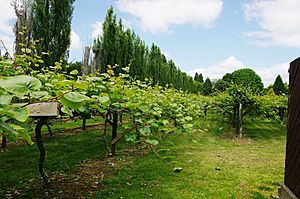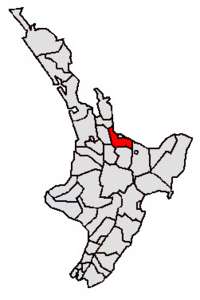Western Bay of Plenty District facts for kids
Quick facts for kids
Western Bay of Plenty District
|
|
|---|---|
|
Territorial authority district
|
|

Kiwifruit orchard at Te Puke
|
|
 |
|
| Country | New Zealand |
| Region | Bay of Plenty |
| Wards | Waihi Beach-Katikati Kaimai Te Puke-Maketu |
| Seat | Greerton, Tauranga |
| Area | |
| • Land | 1,944.42 km2 (750.74 sq mi) |
| Population
(June 2023)
|
|
| • Total | 60,800 |
| Time zone | UTC+12 (NZST) |
| • Summer (DST) | UTC+13 (NZDT) |
| Postcode(s) |
Map of postcodes
|
The Western Bay of Plenty District is a special area in the Bay of Plenty Region of New Zealand. It's like a county or a large local area that has its own council. This district surrounds the city of Tauranga on land. It also includes Matakana Island, which is located at the entrance to Tauranga Harbour.
Contents
About the Western Bay of Plenty
This district covers about 1,944 square kilometers. That's a pretty big area! As of 2018, around 51,321 people lived here. This means there were about 26 people living in each square kilometer.
Some of the main towns in the district include Waihi Beach, Katikati, and Te Puke. Each of these towns has its own unique feel and community.
Who Lives Here?
The population of the Western Bay of Plenty District has been growing. In 2023, the population was 56,184 people. This was a jump of over 5,000 people since 2018. It shows that more and more people are choosing to live in this beautiful area.
| Ethnicity | Population |
|---|---|
| New Zealand European |
45,003
|
| Māori |
12,111
|
| Pasifika |
1,899
|
| Asian |
4,113
|
| MELAA |
426
|
| Other |
741
|
| Historical population | ||
|---|---|---|
| Year | Pop. | ±% p.a. |
| 2006 | 41,826 | — |
| 2013 | 43,323 | +0.50% |
| 2018 | 50,904 | +3.28% |
| 2023 | 56,184 | +1.99% |
The people living in the district come from many different backgrounds. Most people are of European descent, also known as Pākehā. A good number of people are also Māori, who are the native people of New Zealand. There are also communities of Pasifika, Asian, and people from other parts of the world. This mix of cultures makes the district a diverse and interesting place to live.
The average age of people in the district is about 45 years old. This is a bit older than the national average for New Zealand. Many people aged 65 or older live here, making it a popular spot for retirees.
How People Live and Work
In 2018, about 19,869 people worked full-time in the district. Another 7,083 people worked part-time. This shows that many people are employed and contribute to the local economy.
Many people in the Western Bay of Plenty District have completed higher education, with a good number having a university degree. This suggests a skilled workforce in the area.
When it comes to beliefs, about half of the people in the district said they had no religion. Many others identified as Christian. Some people also follow Māori religious beliefs, Hindu, Buddhist, or other religions.
Wards of the District
The Western Bay of Plenty District is divided into smaller areas called wards. These wards help manage the local government and services. Each ward has its own population and characteristics.
| Name | Area (km2) | Population | Density (per km2) | Households | Median age | Median income |
|---|---|---|---|---|---|---|
| Katikati-Waihi Beach Ward | 364.68 | 13,923 | 38.18 | 5,586 | 53.0 years | $26,000 |
| Maketu-Te Puke Ward | 816.69 | 18,423 | 22.56 | 6,162 | 37.7 years | $30,400 |
| Kaimai Ward | 769.66 | 18,969 | 24.65 | 6,714 | 46.1 years | $35,300 |
| New Zealand | 37.4 years | $31,800 |
The three main wards are Katikati-Waihi Beach, Maketu-Te Puke, and Kaimai. Each ward has a different size and number of people living in it. For example, the Katikati-Waihi Beach Ward has an older average age compared to the Maketu-Te Puke Ward. This table gives you a quick look at how these areas compare.

